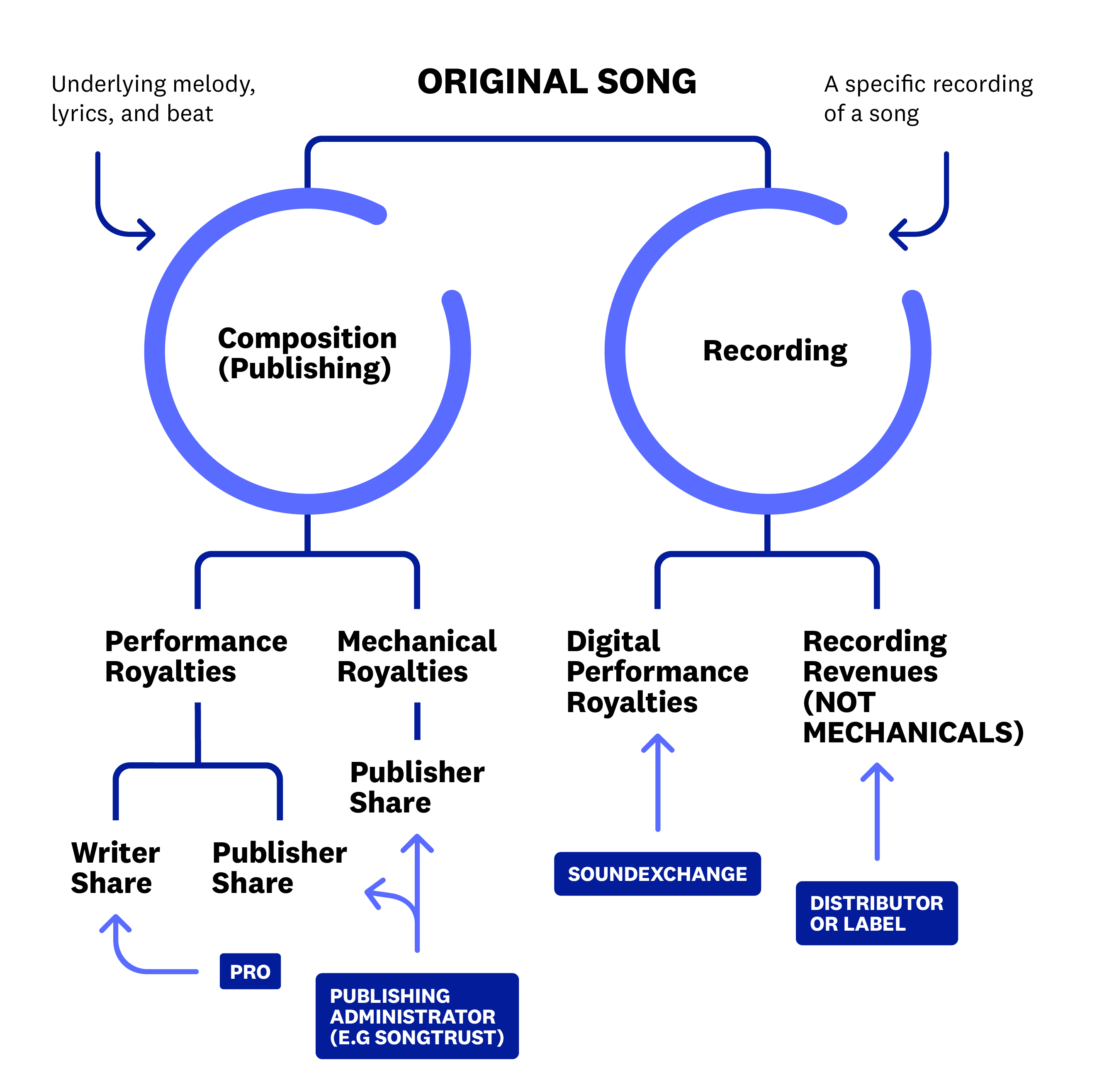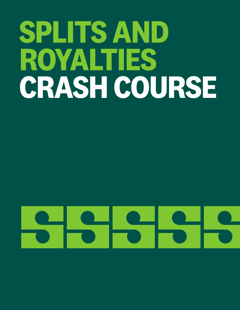Music royalties are payments distributed to you for the use and/or reproduction of your music. To understand the importance of music publishing, a complex but vital piece of your music career, you first have to understand what music royalties are and how they break down based on the two halves of a song. They’re an essential revenue stream for all music creators, and often the biggest. In 2019, the two largest royalty collection societies in the U.S., ASCAP, and BMI, paid out a total of $2.34 billion in music royalties to songwriters, artists, and publishers. That’s only one type of revenue, performance royalties - and only in North America. Imagine the cumulative numbers across all types of royalties and around the world.
Although the definition of music royalties is fairly simple, defining these royalties by how they are earned is a little more complex. The following covers the different types of royalties that can be earned from the use of music and who is entitled to collect royalties from their use.
Two Copyrights, Six Royalty Types
There are two copyrights inherent in a recorded composition or song. One copyright is the recording copyright; the actual sound recording, while the other is the compositional copyright, also known as publishing (the underlying music and lyrics). You would think musicians, publishers, labels, and artists could only collect two royalty types from these two copyrights, but in fact, there are up to six types of royalties that can be generated from these copyrights.

If you are based in the US, recording copyrights generate recording royalties and digital performance royalties, earned when your recording is played on a non-interactive streaming radio, like Pandora. In most countries outside of the US, a recording also earns royalties from neighbouring rights, which are earned when a song is broadcast over the radio.
Compositional copyright can generate four royalty types; mechanical royalties, performance royalties, micro-sync royalties, and print royalties.
The type of royalty earned, and the party owed, depends on the way a piece of music is used in a particular instance.
Who Can Receive Royalty Payments?
Since there are two different copyrights in any piece of recorded music; one for the sound recording (master copyright) and for the music and lyrics (compositional copyright), there can technically be multiple different copyright owners. However, there are many cases where one rightsholder will own both copyrights.
A general word the music industry likes to use to describe these individuals and organizations is “rightsholder”. You’ll hear this word being used a lot throughout your career.
Keep in mind that this table only shows the general rule of copyright ownership. It’s possible for an individual like an independent artist or organization to own both copyrights.
Recording Royalties
Recording royalties are earned from the use or digital reproduction of the sound recording of the music. When music is streamed, downloaded, or sold in a physical format, the rightsholder of the sound recording is due royalties.
Sometimes only the record labels are the recipients of these royalties because they own the rights to the sound recordings. Although today, we’re seeing more and more DIY, independent artists collecting them because they independently finance and distribute their productions - giving them full rights to the sound recordings.
The named recording artist - the performer - on a recording, will earn recording side royalties according to their agreement with their record label or distributor. In some cases, other non-featured performers will also be cut into these royalties, though not always. In addition to the recording rightsholder, there is a small percentage of digital performance royalties (in the US) and neighbouring rights (elsewhere) payable to non-featured recording musicians.
Recording rightsholders also earn “sync” licensing fees when their recording is used in an advertisement, television show, or film, and depending on their leverage, may also earn royalties based on the movie grosses or TV show audiences.
Compositional, or Publishing, Royalties
Remember - compositional, or publishing, royalties are broken down further into four main buckets: mechanical, performance, micro-sync, and print royalties. There are many ways your song can earn royalties, so make sure you do your research to ensure you’re maximizing your revenue.
Mechanical Royalties
Mechanical royalties are owed to you when music featuring your composition is physically or digitally reproduced. For example, if your EP is streamed or pressed to vinyl, you are due mechanical royalties.
These mechanical royalties are collected by pay sources and collection societies such as The MLC in the US, mechanical rights organizations (MROs), or collective management organizations (CMOs), and paid out to the songwriter or their publisher. Streaming mechanical royalties are collected via blanket licenses with the Digital Service Providers (such as Apple Music, Spotify, or Deezer), while physical-mechanical royalties (such as those earned by pressing a vinyl record), are paid based on individual licenses, often requested directly from a publisher.
For a deeper dive into mechanical royalties, including how they are collected, check out this article.
Performance Royalties
Performance royalties are earned when your music (composition) is played or performed in a public setting, whether it’s being performed live at a music venue (whether played by you or someone else), at a bar or coffee shop, or over the radio. Note that streams from on-demand streaming services, like Spotify or Apple Music, earn both a performance royalty and a mechanical royalty - this is unique among types of music usage. The creator and or owners of the music - songwriters or their publishers - collect performance royalties.
All performance royalties are collected and distributed by collection societies such as performing rights organizations (PROs) or collective management organizations (CMOs) to the relevant rightsholders.
Other Royalties
Thanks to the global music industry’s efforts to bring music licensing to the internet, rightsholders can earn royalties from online platforms like Instagram, TikTok, and Youtube when their music is synchronized to videos. These are referred to as “micro-sync royalties”, and they earn both performance and mechanical royalties, depending on the licenses each platform has in place.
Printing sheet music and selling it generates print music royalties for the composer and publisher. It is the oldest form of music publishing. As you can imagine, printing sheet music isn’t as lucrative as it once was but it can be a significant source of income for songwriters in certain genres.
Final Words
In short, there are generally six types of music royalties; recording, digital performance, mechanical, performance, micro-sync, and print royalties. You need to identify what type of rightsholder you are to know what type of royalties you are entitled to. Next, find out how your music is being used, or can be used, to earn royalties. Is an artist covering your song at a festival? Is it being featured in the latest Netflix series? Since music royalties are an essential part of any music creator’s (or owner’s) revenue stream, doing your research can go a long way to helping you make better business decisions for your music career.
If you have questions about music royalties, music publishing, or Songtrust, sign up for one of our Music Publishing 101 workshops, check out our help center, or reach out directly to our team.






